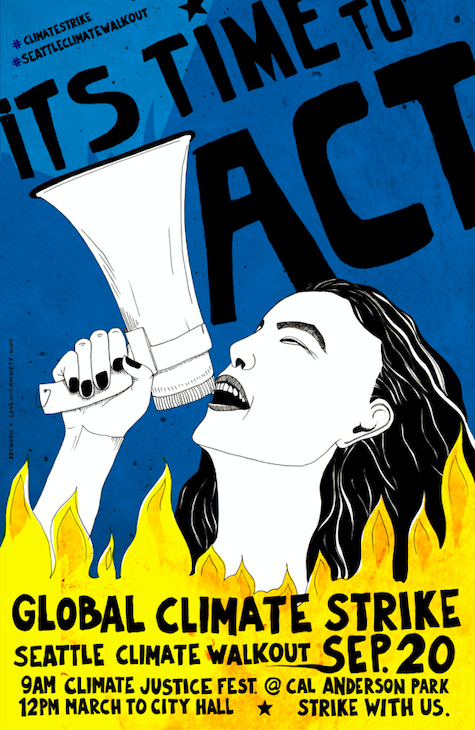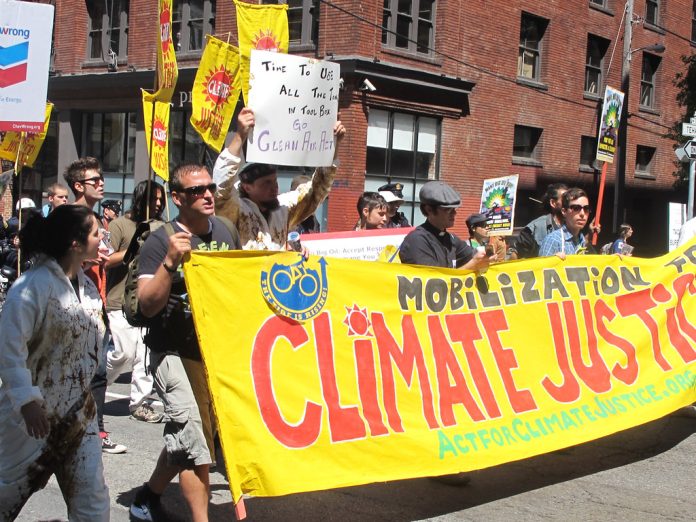“The sea levels are rising, and so are we.” On Friday, September 20th, over 500 climate strikes are planned across the United States. Additionally, strikers will be taking to the streets in over 117 countries worldwide demanding climate action. It will be the single biggest day of protest since the publication of a report by Intergovernmental Panel on Climate Change (IPCC) last October declared “urgent and unprecedented changes” were needed within the next 12 years to prevent global climate crisis.
“I’m striking on September 20th to call attention to the minority communities who aren’t thinking of the ‘if’ and ‘when’s’ that often populate the climate conversation, but who are forced to live through the catastrophic effects of climate change that are happening right now, today and everyday,” said Kimaya Mahajan, 15, an organizer with WA Youth Climate Strikes. “I strike to remind people that climate change is not a far-off issue, and if we open our eyes wide enough, we will see the havoc it’s wreaking right in front of us.”

The Global Climate Strike is part of a youth led movement inspired by the actions of Greta Thunberg, a Swedish teenager whose strike in front of Sweden’s parliamentary building gained international recognition. Thunberg, who has been nominated for the Nobel Peace Prize, is currently in New York City, where on September 20th she will urging leaders at the UN Climate Action Summit to do more to address the crisis. Mayor Bill de Blasio has agreed to excuse absences for NYC public school students who participate in the strike.
In Seattle, on September 20th strikers will gather at Cal Anderson Park from 9am-12:30pm for a Climate Justice Fest with activities, art, music, games, and workshops. At 12:30pm, organizers and attendees will march to Seattle’s City Hall to demand transformational action at the scale of the crisis.
Not limited to just kids, the movement is also calling on adults to stand in solidarity as allies. Labor movements, social justice organizations, and faith communities are also being called to participate in the climate strike.
Additionally, more than one thousand Amazon employees have pledged to walk out on September 20th to show support for a group of 8,200 Amazon employees who have publicly called on the company to release a plan for how the company would reduce its reliance on fossil fuels with a zero carbon emissions target of 2030.
“Young people all around the world have been striking from school to call attention to the climate crisis. We’re answering their call to walk out because our role, as employees of one of the largest companies in the world, means we need to push for a climate plan that gets us to zero emissions company-wide by 2030,” said Bobby Gordon, a Finance Manager at Amazon in Seattle.
The Amazon employees will gather at the Amazon Spheres from 11:30-12:30 and then head over to City Hall to join the city-wide rally.
The climate crisis is already harming vulnerable people
It is getting harder and harder to ignore how the climate crisis is harming vulnerable people and ecosystems across the world. In Somalia, currently 2.1 million people are threatened with starvation after an “erratic climate” led to the worst harvest since 2011. The Bahamas is currently bracing for the impact of another tropical storm only two weeks after Hurricane Dorian wrecked havoc across the small Caribbean nation. A report published by Science Advances has found that by 2050 thousands of islands could be become uninhabitable because of sea level rise and flooding caused by storms.
“We have always lived through hot summers. But this is not the summer of our youth,” warned UN Secretary General António Guterres in a press statement in which he went on to describe how the world is on track for 2015-2019 to be the “hottest five years on record.”
The potential for the climate crisis to cause human suffering has led to UN High Commissioner for Human Right Michelle Bachelet to declare “The world has never seen a threat to human rights of this scope.”
We need a green global economy
As an American living under President Donald Trump, climate crisis denier-in-chief, whose administration has engaged in rolling back eighty five important environmental protection rules, it’s easy to feel that situation is all doom and gloom. But according to the UN, there are reasons to be hopeful.
While the US is continuing business as usual in the energy sector, other smaller countries, like Chile, Ireland, Kenya and Costa Rica are investing significantly in renewable energy.

“We have the solutions that we need to address climate change, but we need to use them,” writes the UN news in an article that highlights how the world already has both the technology and finances necessary to prevent a future in which the global temperatures rising about 3 degrees Celsius within our lifetimes.
But the UN does acknowledge that what the world really needs now is for major polluters, like the US, to step up and become leaders in a transition toward a new green economy.
By passing a Clean Energy bill that eliminates coal power by 2025 in the last legislative session, Washington State has already emerged as a leader among US states in the transition toward a carbon neutral future. And the presence of Governor Jay Inslee on the presidential election trail, did help to elevate the importance of combatting the climate crisis in the Democratic primary debates. But we can all do more.
By showing up to the Global Climate Strike on September 20th, you can help show the world that Americans should not be defined by the harmful policies of the climate crisis denier-in-chief.
Other ways to be involved in the fight for climate justice also include coming out to protest again Chase Bank’s financing of the fossil fuel industry on September 18th with 350 Seattle and taking the individual actions included the UN’s ActNow campaign, such as eating less meat and using more fossil fuel free transportation.
Natalie Bicknell Argerious (she/her) is a reporter and podcast host at The Urbanist. She previously served as managing editor. A passionate urban explorer since childhood, she loves learning how to make cities more inclusive, vibrant, and environmentally resilient. You can often find her wandering around Seattle's Central District and Capitol Hill with her dogs and cat. Email her at natalie [at] theurbanist [dot] org.



